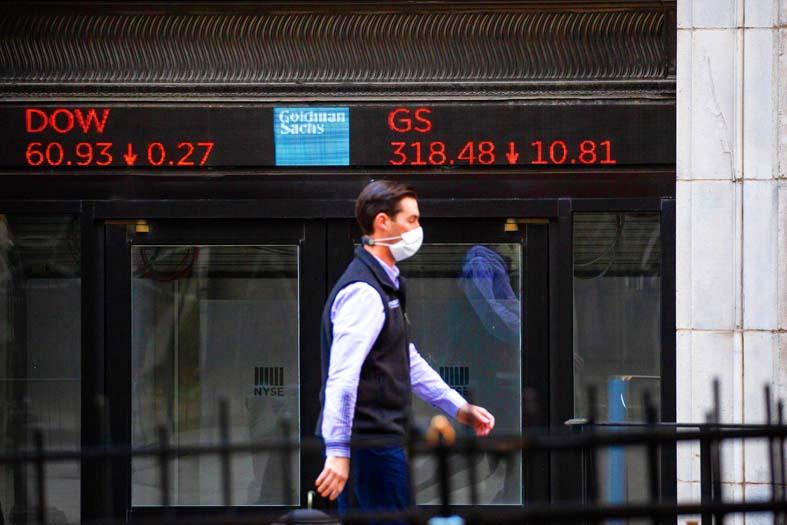Goldman Sachs Group Inc is seeing substantial demand for digital assets from institutions as it works to restart its cryptocurrency trading desk.
In a survey of nearly 300 clients by the firm, 40 percent have exposure to crypto, said Matt McDermott, global head of digital assets for Goldman Sachs Global Markets Division, speaking on a podcast.
The situation is different now compared with the 2017 bitcoin bubble, due to “huge” institutional demand across different industry types and from private banking clients, he said.

Photo: Michael Nagle, Bloomberg
McDermott confirmed plans reported last week for Goldman to restart its crypto trading desk, which he said would be “quite narrow initially,” with a focus on areas such as CME Group Inc futures.
He said that US banks need to cope with regulations that bar them from trading physical cryptocurrencies.
Cryptocurrency enthusiasts argue that digital tokens and the underlying blockchain technology are gaining acceptance among more mainstream institutions.
The derivatives market and new investment products have made digital assets more easily accessible. Some strategists posit that the asset class is a potential diversifier for portfolios, while others are more skeptical and blame speculators for inflating a possible bubble in bitcoin and other cryptos.
Bitcoin yesterday rose as much as 3.4 percent in Asia, while ether gained as much as 5.3 percent to the highest since Feb. 23.
Blockchain technology offers “a real diverse set of opportunities for the financial industry,” McDermott said.
As for prices, 76 percent of those surveyed see bitcoin ending this year between US$40,000 and US$100,000, McDermott said.
However, 22 percent expect it to end the year above US$100,000.

With this year’s Semicon Taiwan trade show set to kick off on Wednesday, market attention has turned to the mass production of advanced packaging technologies and capacity expansion in Taiwan and the US. With traditional scaling reaching physical limits, heterogeneous integration and packaging technologies have emerged as key solutions. Surging demand for artificial intelligence (AI), high-performance computing (HPC) and high-bandwidth memory (HBM) chips has put technologies such as chip-on-wafer-on-substrate (CoWoS), integrated fan-out (InFO), system on integrated chips (SoIC), 3D IC and fan-out panel-level packaging (FOPLP) at the center of semiconductor innovation, making them a major focus at this year’s trade show, according

SEMICONDUCTOR SERVICES: A company executive said that Taiwanese firms must think about how to participate in global supply chains and lift their competitiveness Taiwan Semiconductor Manufacturing Co (TSMC, 台積電) yesterday said it expects to launch its first multifunctional service center in Pingtung County in the middle of 2027, in a bid to foster a resilient high-tech facility construction ecosystem. TSMC broached the idea of creating a center two or three years ago when it started building new manufacturing capacity in the US and Japan, the company said. The center, dubbed an “ecosystem park,” would assist local manufacturing facility construction partners to upgrade their capabilities and secure more deals from other global chipmakers such as Intel Corp, Micron Technology Inc and Infineon Technologies AG, TSMC said. It

DEBUT: The trade show is to feature 17 national pavilions, a new high for the event, including from Canada, Costa Rica, Lithuania, Sweden and Vietnam for the first time The Semicon Taiwan trade show, which opens on Wednesday, is expected to see a new high in the number of exhibitors and visitors from around the world, said its organizer, SEMI, which has described the annual event as the “Olympics of the semiconductor industry.” SEMI, which represents companies in the electronics manufacturing and design supply chain, and touts the annual exhibition as the most influential semiconductor trade show in the world, said more than 1,200 enterprises from 56 countries are to showcase their innovations across more than 4,100 booths, and that the event could attract 100,000 visitors. This year’s event features 17

EXPORT GROWTH: The AI boom has shortened chip cycles to just one year, putting pressure on chipmakers to accelerate development and expand packaging capacity Developing a localized supply chain for advanced packaging equipment is critical for keeping pace with customers’ increasingly shrinking time-to-market cycles for new artificial intelligence (AI) chips, Taiwan Semiconductor Manufacturing Co (TSMC, 台積電) said yesterday. Spurred on by the AI revolution, customers are accelerating product upgrades to nearly every year, compared with the two to three-year development cadence in the past, TSMC vice president of advanced packaging technology and service Jun He (何軍) said at a 3D IC Global Summit organized by SEMI in Taipei. These shortened cycles put heavy pressure on chipmakers, as the entire process — from chip design to mass